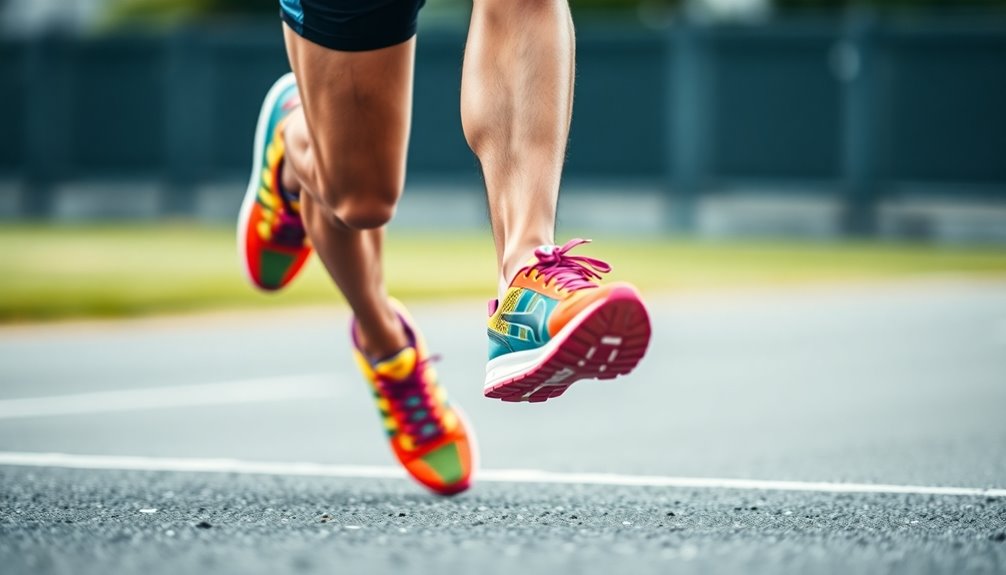Proper running form is essential for everyone, whether you’re a beginner or an experienced runner. Focus on aligning your head, maintaining a tall posture, and relaxing your shoulders. Engage your glutes for stability, avoid overstriding, and choose quick, light foot placements. Monitor your arm swing and keep it natural to save energy. Understanding your body type and utilizing tools can enhance your performance. There’s so much more to explore about refining your technique and maximizing results. To further improve your running experience, it’s important to incorporate strength training and flexibility exercises into your routine. These will help you build the necessary muscle and reduce the risk of injury, allowing you to run more efficiently. By dedicating time to practice and perfect your skills, you can truly master your running form techniques and elevate your performance to new heights.
Key Takeaways
- Focus on maintaining a tall posture with aligned head and spine to enhance running efficiency and prevent strain.
- Engage your glutes and hips for stability, which helps to improve stride power and prevent injuries.
- Aim for a mid-foot strike to minimize impact and conserve energy while running.
- Regularly check your form and adjust your cadence to find a comfortable and efficient running rhythm.
- Utilize running apps or coaches for personalized feedback and continuous improvement in your running technique.
Importance of Running Form

Running form plays an essential role in your overall performance and injury prevention. When you focus on proper running form, you not only enhance your efficiency but also reduce physical stress on your body.
Developing awareness of your alignment is important; keep your head upright and shoulders relaxed to promote better body mechanics. Engaging your glutes and hamstrings while maintaining balanced lower body mechanics guarantees stability and efficient movement.
Additionally, practicing proper foot placement with a light forefoot or mid-foot strike minimizes impact, lowering the risk of injury. This technique encourages quicker strides, enhancing energy conservation and endurance.
Mastering Proper Running Technique

To master proper running technique, you need to focus on head and body alignment, as well as your arm and leg mechanics.
A light foot strike is essential for reducing impact and conserving energy, so pay attention to how your feet connect with the ground.
Head and Body Alignment
While maintaining proper head and body alignment may seem simple, it's essential for enhancing your running efficiency and preventing injury.
Start by keeping your head upright, ensuring your line of sight is straight ahead while your neck remains neutral. Relax your shoulders, pulling them down and back to promote a tall posture, as hunching can hinder good running form.
Your arms should stay at a controlled 90-degree angle, swinging naturally at your sides to aid in forward propulsion. Engage your hips to maintain stability, preventing them from dropping to one side, and actively use your glutes and hamstrings for better control.
Regularly check your alignment, focusing on a neutral pelvis and proper arm movement for ideal technique. Furthermore, maintaining hydration and nutrition is critical to preventing fatigue that can arise from poor running form.
Arm and Leg Mechanics
Mastering your arm and leg mechanics is essential for running efficiently and preventing injuries. Keep your elbows at a controlled 90-degree angle, allowing your arms to swing naturally at your sides. Avoid crossing them in front of your body.
Engage your hips to stabilize your gait and promote leg drive. Focus on shorter strides with increased cadence to prevent overstriding, making each step more efficient.
- Feel the rhythm of your breath as your legs propel you forward.
- Embrace the freedom of a smooth, powerful stride.
- Experience the joy of running injury-free.
Foot Strike Technique
Achieving an effective foot strike technique is essential for enhancing your running performance and minimizing the risk of injury. Aim for a light forefoot or mid-foot strike to reduce impact and conserve energy. This technique helps you avoid heavy footfalls and shuffling—practice quicker foot placement for better stride efficiency.
Land about 10 degrees in front of your hips to maintain proper alignment and improve running economy. Engaging your glutes and hamstrings during your stride creates a balanced leg drive, enhancing control. Regularly monitor your foot placement to prevent overstriding; shorter, quicker strides are generally more energy-efficient.
Invest in quality running shoes that support your foot strike technique, as they can greatly impact your overall performance and comfort.
Head Posture and Alignment

Maintaining proper head posture and alignment is essential for every runner. An upright head with your gaze focused several meters ahead not only enhances your vision but also improves your overall body alignment. This reduces the risk of neck strain and promotes better running efficiency.
- Feel the freedom of movement with every stride
- Enjoy the confidence that comes from solid form
- Experience fewer injuries and a more enjoyable run
A neutral neck position is vital; excessive tilting can disrupt your balance. Regularly check your head position to prevent leaning forward, which can lead to poor form.
Keeping your head aligned with your spine fosters a tall posture, optimizing energy transfer and enhancing your performance on the run.
Upper Body Mechanics

Once you've established good head posture and alignment, the next focus should be on your upper body mechanics. Keeping your shoulders relaxed and pulled down and back is essential for maintaining a tall posture, which prevents hunching and promotes better running form.
Position your arms at a controlled 90-degree angle, swinging them naturally at your sides to aid forward propulsion without crossing in front of your body. Engaging your upper body correctly enhances running efficiency, allowing for ideal energy expenditure and improved endurance throughout your run.
Regularly check and adjust your arm swing to avoid unnecessary energy loss, contributing to a smoother running rhythm. A neutral head position supports overall body mechanics, ensuring effective upper body alignment as you run.
Lower Body Mechanics

When you're running, keeping your hips stable is essential for preventing injuries and maintaining efficiency.
Engaging your glutes effectively and ensuring a balanced leg drive will enhance your performance and control.
Hip Stability Importance
Hip stability plays an essential role in your running form, as it helps prevent weight shifts that can lead to imbalances and inefficient movement.
When you maintain strong hip stability, you guarantee proper alignment and reduce the risk of hip dropping, which can cause scuffing of shoes on the opposite leg.
- Feel the freedom of smooth, effortless strides.
- Experience fewer injuries and more enjoyable runs.
- Enjoy the confidence that comes from improved performance.
Engaging Glutes Effectively
Engaging your glutes effectively can transform your running experience by enhancing stability and power with every stride. By activating your glutes, you prevent hip drop, which leads to more efficient movement and reduces injury risks. Strong glutes drive your legs forward and upward, enhancing your overall running efficiency.
To build glute strength, incorporate exercises like squats, lunges, and hip bridges into your routine. Always monitor hip alignment to guarantee both sides engage equally, preventing compensatory movements.
| Exercise | Benefit | Frequency |
|---|---|---|
| Squats | Strengthens glutes | 2-3 times/week |
| Lunges | Improves control | 2-3 times/week |
| Hip Bridges | Boosts power generation | 2-3 times/week |
Pair these exercises with a good pair of running shoes, and you'll elevate your running performance.
Balanced Leg Drive
A balanced leg drive is essential for efficient running, as it harnesses the power of both your glutes and hamstrings. To achieve the best running form, keep your hips level and avoid shifting your weight. This prevents hip dropping and saves your shoes from unnecessary scuffing.
Focus on quick, light foot placements to conserve energy and minimize impact stress.
- Feel the strength in every stride.
- Experience the freedom of controlled movement.
- Enjoy the thrill of running injury-free.
Maintain a relaxed upper body while your legs execute a controlled drive. Guarantee your arms swing in sync with your leg movement for better propulsion.
Regularly practice drills like short sprints to enhance your balanced leg drive and overall efficiency.
Foot Placement and Impact

While you mightn't think about it during your run, foot placement and impact play an essential role in your overall performance and injury prevention. Aim for a light forefoot or mid-foot strike to minimize impact on your joints, promoting better energy efficiency.
Avoid heavy footfalls and shuffling by focusing on quicker, lighter steps, which can enhance your running performance. Monitor your foot placement to prevent overstriding; landing about 10 degrees in front of your hips is ideal.
Engaging your glutes and hamstrings helps maintain control and stability, contributing to balanced leg drive. Practicing proper foot placement and impact techniques can also facilitate better recovery after runs, reducing fatigue and soreness in the days that follow.
Adapting Technique to Body Type

To run efficiently, it's vital to adapt your technique to your unique body type. Start by evaluating your leg and stride length; these factors greatly influence your comfort and performance.
Adjust your cadence to what feels right for you—it can enhance your overall running experience. Understanding your foot type is also essential for selecting the right shoes, which can help prevent injuries.
- Feel the joy of running without pain.
- Discover your personal rhythm and flow.
- Release your potential with tailored techniques.
As you start running, incorporate flexibility and strength training into your routine.
Regularly review your form and make adjustments based on personal feedback. This approach leads to considerable improvements in your running performance.
Tools and Resources for Improvement

Improving your running form doesn't just rely on understanding your body type; it also involves utilizing the right tools and resources.
Start by downloading running apps that track your progress and analyze your form, helping you pinpoint areas to improve. Consider hiring a certified running coach for personalized feedback and guidance.
Recording your runs can also provide insight into your technique, allowing you to spot recurring issues. Join group runs to gain motivation and receive constructive feedback from others, exposing you to various running styles.
Finally, invest in running belts for convenience and ease during long runs, ensuring you have everything you need at hand while focusing on enhancing your form with targeted drills and exercises. Additionally, understanding your risk tolerance can help you choose appropriate goals and methods for your running journey.
Frequently Asked Questions
How to Correct Running Form for Beginners?
To correct your running form as a beginner, start by keeping your head upright and your gaze forward.
Relax your shoulders and maintain your arms at a 90-degree angle, swinging naturally.
Focus on a balanced hip position while engaging your glutes and hamstrings.
Aim for a light mid-foot strike, landing just ahead of your hips to reduce impact.
Don't forget to stretch dynamically before runs and foam roll afterward for better recovery.
What Is the 80% Rule in Running?
The 80% rule in running balances your training by guiding you to run 80% of your miles at an easy pace, while reserving 20% for harder workouts.
This method builds your endurance and helps you avoid injuries. By focusing on easier runs, you'll enjoy your training more, stay motivated, and develop a solid fitness base.
Incorporating this strategy can lead to improved performance and a more sustainable running routine overall.
What Is the 5 4 3 2 1 Running Drill?
The 5 4 3 2 1 running drill's a structured warm-up that progressively prepares you for your workout.
You start with 5 minutes at an easy pace, then shift to 4 minutes faster, 3 minutes at tempo, 2 minutes near-sprint, and finish with 1 minute at maximum effort.
This drill enhances your cardiovascular endurance and helps reduce injury risk while improving your pacing and energy management for more intense runs.
How to Run Beginner Form?
Think of your body as a well-tuned instrument. To play it right, you need an upright posture, with your gaze focused ahead.
Keep your shoulders relaxed and arms swinging naturally at a 90-degree angle. Engage your glutes and hamstrings for a strong leg drive, aiming for a light mid-foot strike to minimize impact.
Conclusion
Incorporating proper running form can feel like strapping on a pair of rocket boosters! When you nail your technique, you'll glide through the air like a gazelle, leaving clouds of dust behind. You'll not only run faster but also feel lighter than a feather, as if you're floating on a magic carpet. So, embrace these tips and watch your running transform into an exhilarating experience that makes every stride feel like a victory lap!









